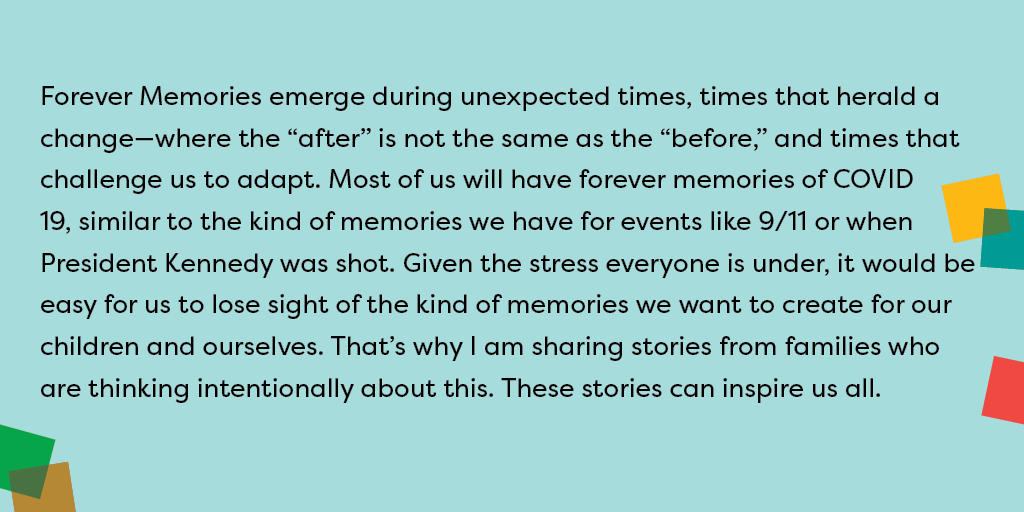Bringing The Outside In
By Ellen Galinsky

 Kathy describes her granddaughter to me:
Kathy describes her granddaughter to me:
Ellie is four and three quarters—almost five. That three-quarters is very important to her!
She continues:
Ellie likes to climb; she likes to run; she likes to do gymnastics.Sadly, none of the places where you can do any of those things is open. This week, she couldn’t go outside at all. It was kind of terrible.
Kathy didn’t linger on the fact that her granddaughter was stuck inside. She turned it into a challenge, focusing instead on ways to bring outside-type activities into her house.
We HAD to figure out a way to get all of that energy out.
Kathy is not new to this—as a psychologist she has studied and created initiatives on playful learning. What’s wonderful is that her ideas can inspire our own ideas. Here’s what she did.
First, Kathy created a timed obstacle course in her house. The start line was at the top of the stairs and the finish line took Ellie back up the stairs again. The course was marked with masking tape, which Kathy cut into the shape of arrows. She then attached the arrows on the wooden floor, on the couch and the carpet. Her couch is in sections, so she pulled them apart:
Ellie would run down the stairs, following the arrows. They led her to the couch. She had to mount the first section of the couch. I made it wide enough so that it was a challenge for her to figure out how to jump from the first section to the second section.
Kathy laughed, telling the story of how Ellie figured out her maneuvers:
She decided the best way was to go stomach forward. She did an army crawl across the sections of the couch.
Kathy found an old ring game and set that up at the end of the couch so Ellie had to throw rings and try to get them to land on the pegs.
The timed obstacle course doesn’t depend on having a ring game or a sectional couch. If you want to add a throwing game, you can create your own, such as throwing something that do damage inside the house onto pieces of paper at varying distances. The obstacle course can also go anywhere—over, under and across any furniture you have.
The next game was Play That Tune, which Kathy describes:
Imagine that you are facing a table. On the table, there are three bowls of different sizes and colors. They are turned upside down.
If you don’t have different colored or safe bowls, you can improvise and use different-sized objects as drums.
On the wall, directly above the three bowls, Kathy taped a pattern of three colored strips to the wall that indicates the order of the bowls that Ellie is supposed to play. Kathy says:
So, let’s say the bowls were blue, yellow and white, which were my colors.I made strips of those colors on the wall in this pattern: blue, blue, white. Blue, blue yellow. Blue, blue white.
When Ellie saw the pattern “blue, blue, white,” she took the wooden spoon and hit the blue bowl once, hit the blue bowl twice, then hit the white bowl. Kathy continues:
It turns out that doing that fast is even hard for adults. It’s quite a challenge.
The next game was Shapes. For this game, Kathy cut out triangles, circles and squares that she taped to the floor, forming a pattern from a start to a finish line. The challenge is for Ellie to run this relay only going on triangles, only on squares or only on circles.
Ellie is getting really good at leaping from the first to the second to the third triangle. I time her and she goes again and again and again to see if she can beat her time.
The final game for Inside Time was Composer’s Corner, where they wrote a song together. Writing a song is not so easy. The words have to make sense as well as rhyme and every line has to have a certain number of beats.
The outside may be “closed,” but inside is “open.” With some masking tape, colored paper, and kitchen bowls or any other objects you find around the house, you can create an inside playground where joy-filled playful learning happens.
Challenge can beget challenge. Turning an adult challenge into a challenge for children, all in fun ways, not only inspires learning, it promotes the life skill of Taking on Challenges.
Reprinted with permission from Families and Work Institute.
